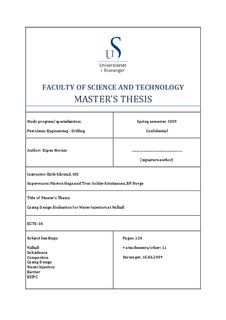| dc.description.abstract | The Valhall field is the largest field that BP operates on the Norwegian Continental Shelf, and is one
of the most well known high porosity chalk fields in the Southern part of the North Sea. During many
years of oil production, there has been compaction of the reservoir. The current casing design at
Valhall has developed with time as the field has matured, and is affected by several considerations
like casing shear in the overburden due to subsidence, non-uniform loading in the reservoir due to
chalk production and compaction.
The main objective of this thesis was to develop options that could be included in the current casing
design, to guarantee a higher injection pressure than is available today at the Valhall field. The
current design is limiting the maximum injection pressure in the water injectors, and the main factor
is the use of 95/8” drilling liner combined with a cement squeeze job through a C-Flex port collar. This
cement job is not approved as a barrier element as required by NORSOK. The injection pressure is
today limited by the strength of the 133/8” casing shoe, which is lower than desired.
The study involves reviewing BP’s casing design manual, the current casing design on Valhall, the
special requirements for Valhall, and investigating several technologies that could provide potential
solutions to the barrier challenges on Valhall.
The recommended option is to include the External Sleeve Inflatable Packer Collar (ESIPC), Cement
Assurance Tool and the C-Flex in the 95/8” drilling liner. The ESIPC would provide a good cement job
in the liner annulus, as it would enable returns to be observed during the cement job, providing
evidence that there is a cement column behind the drilling liner by a cement bond log. The C-Flex is
included to make it possible to perform a cement squeeze job through the C-Flex additionally to the
ESIPC or in worst case alone if the ESIPC fails. The Cement Assurance Tool is just an extra safety in
case the cement around the liner would contract and make a micro-annulus, which could create a
possible leak.
This option would most likely provide a barrier element according to NORSOK. This barrier element is
very important to be able to increase the injection pressure at a wanted level, which is approximately
6,300 psi.
At present time, the ESIPC is not strong enough to be included in a drilling liner. It has to be
reinforced and tested before it could be included in the drilling liner to be able to withstand the large
forces acting on the tool. The corresponding dual bottom-top wiper plug set has to be reinforced as
well, because the plug set would be exposed to large forces during the losses, and when it is set
inside the ESIPC. | no_NO |
